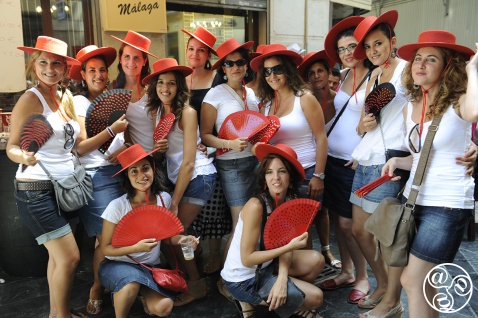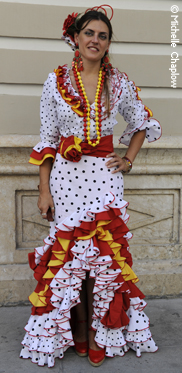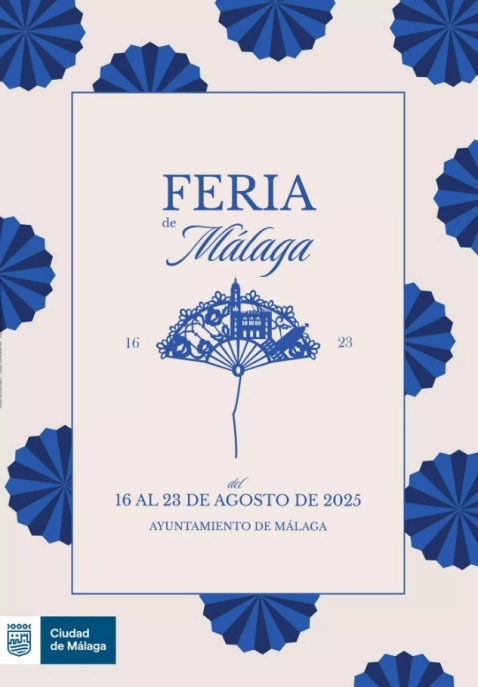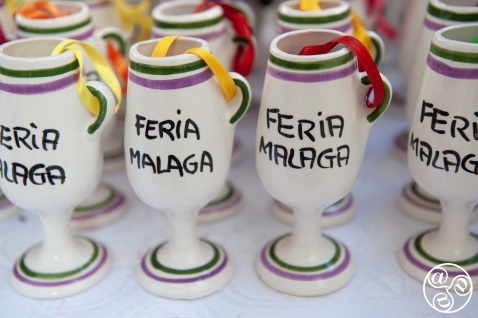
Local Malagueñas enjoying their home town feria. |
|
Sat 16th to Sat 23rd Aug 2025
(confirmed by the Town Hall in May)
Malaga Feria
The annual Malaga city fair in August is an exuberant week-long street party with plenty of flamenco and 'fino' (sherry). The fair commemorates the re-conquest of the city by Isabella and Ferdinand in 1487 and traditionally runs for a week from Saturday to Sunday (inclusive) over the third week in August.
The dates for Malaga Feria 2025 are Sat 16th to Sat 23rd August 2025 inclusive, as confirmed by the City Council meeting on 23rd May 2025. The local by-laws state that since the purpose of the fair is to celebrate the incorporation of Malaga into the Crown of Castile (19th August 1487), it must be centered on this date, which is also a local public holiday.
This castanet-clicking fiesta starts off with a bang, literally, with an impressive firework display in the Paseo del Parque which can be seen for miles around. The best view is from the Port area or Muelle Uno or from the rooftop terrace bars of city centre hotels. The firework display is at midnight on the Friday night before the opening Saturday. This was usually (but not since 2022) followed by a free concert by a top Spanish artist or band on the beach at La Malagueta.
The following day the people take to the streets, the women in flouncy flamenco dresses, to dance, drink and, generally, make merry. The traditional dance of Andalucia is called 'Sevillanas' comprising four distinct dances with plenty of finger-clicking, foot-stomping and, above all, feeling. This is where 'dancing in the street' can be appreciated spontaneously 'en vida' which is really the only way Spanish dancing should be performed.
Millions of people visit the fair, although very few tourists know about this intrinsically Andalusian traditional fiesta which, in Malaga, is two distinct events, in the centre during the day (Feria de Dia - Day fair) up to 18.00 hrs in the city centre and (Feria de Noche - Night fair) from around 21.00 hrs until dawn in the fairground west of the city centre.
Feria de Dia - Day fair
This city fair is concentrated around Malaga's main shopping street - Calle Marques de Larios (Calle Larios for short) which is decorated with paper lanterns and flags. Millions of people visit the fair, although very few tourists seem to even know about this intrinsically Andalusian traditional fiesta which, in Malaga, is two distinct events, in the centre during the day (Feria de Dia - Day fair) up to 18.00 hrs and at the fairground (Feria de Noche - Night fair) from around 21.00 hrs until dawn.
Hundreds of people take to the streets of the city’s historic centre, which are beautifully decorated and food, drink and trinket stalls are set up. Shops and businesses close and the classy pedestrian shopping street, Calle Marques de Larios, and surrounding area are transformed for the duration of the celebrations. Soak in the wall-to-wall swishing flamenco dresses, gleaming Andalusian horses, music and spontaneous dancing and you understand something of the Andalusian love of life and ability to party.
Read account of visit to Malaga day fair
Feria de Noche - Night Time fair
The Feria de Noche is an immense precinct to the west of the MA-20 by-pass motorway near the Palacio de Congresos building where various associations install their 'casetas' - large huts or booths for entertainment and refreshment, where old and young alike meet up in laughing gossiping circles, surrounded by swirling dancers and waiters rushing around tripping over babies and young children and making sure that everyone is continually topped up with fino and 'tapas'. The casetas are much more open to the public those in Seville. As long as you are dressed (anything from smart casual upwards), ask the dorman politely and you can enter. The 'Caseta municipal' has a wide range of acts and live music, most are free except for some headline acts..
The casetas are also where many business deals are struck between local Malagueños who have closed their conventional office for the week. Outside, the fair is a gaudy, raucous fairyland of dazzling lights, deafening music, soaring ferris wheels and careering dodgem cars, an assault on all the senses and incomparable to any 'conventional' fair elsewhere.
The typical feria drinks are Malaga Dulce (Malaga sweet) wine and Rebujito ( fino or manzanilla mixed with lemonade or sprite). Typical feria food is Pescaito which is a selection of fried fish from Malaga.
This festival of light by night is just one aspect of the ‘Feria de Málaga’. The inaugural (Friday) night of the Fair is launched with the traditional‘Pregón de la Feria’ (opening address) read out from the Town Hall balcony. Unusually in 2022 singer María Peláe delivered the Pregón on the Saturday evening before the turning on of the lights. Manuel Bandera, Estrella Morente, Antonio Banderas, Diana Navarro, Julio Iglesias, María Teresa Campos, Pasión Vega and many others have had the honor of the Pregón in previous years. On the Friday strike at 23.50 there is a drone display and at midnight starts an awe-inspiring fireworks display. This ‘Big Bang’ is a magnificent show of Malaga’s muscle in the party prowess department and is best appreciated from Malaga Port and Muelle Uno, where thousands gather vying for a privileged view of this magical scene. This was followed by a free concert by a top Spanish artist or band on the beach at La Malagueta, but this has not been held since 2022 due to environmental concerns.
By night the place to be is the Feria de Noche at the big purpose built Fair Ground also called 'El Real', set just on the edge of the city, west of the MA-20 near the Palacio de Congresos. There are shuttle buses laid on from the Alameda in centre of the city. The Cercanias train station 'Victoria Kent' is the nearest. From around 21.00 hrs till dawn this massive purpose built fiesta area vibrates with life. Here, 21 st century technology mingles with old Andalusian traditions. From fairground rides, to live music and dancing and endless food, drink and entertainment, the choice is vast. If you do nothing other than people-watch. You will enjoy a sense of theatre when you see the stunning elegance and beauty of some of the women and men milling around or dancing traditional Sevillanas, till dawn. However the number of people wearing traditional dress is slowly diminishing over the years, cost and heat are cited as the reasons.
Brief History of the malaga feria

'Faralae' dresses are typical of Malaga Feria.
The Feria celebrations date back to 1487, when Los Reyes Católicos, Isabella and Ferdinand re-conquered the city. Over time, it has evolved into a huge event and it has two distinct facets – day and night. ‘La Feria de día’ warms up around midday. Restaurant and bars are full and spill over into the street. Bands play free concerts in the little squares of the city centre. Head for Calle Larios and follow the crowds. This Feria de dia officially finishes at 18.00 hrs This finishing time is earlier than some years ago and is now strictly observed by bars who turn off the music. The feria goers and in particular the younger prefer to hang around and finish their drinks. The street cleaners and their hose pipes arrive in force and mark the real end to the Feria de dia.
The third part of the Malaga Feria are the bullfights in the city’s bullring at La Malagueta.
Other fairs in Andalucia
The Andalucian feria is also celebrated in the majority of towns and even villages at some time between Spring and Autumn and for the locals means far more than a holiday from work. They are the very reason and justification for the year, occasions to be immersed in with passion and commitment. Some, like Malaga, Cordoba and, particularly Seville are rich and glittering affairs attracting millions of visitors while others, such as the feria of the village of Casares is a far smaller version; an exuberant street party where everyone knows everyone and relatives who have moved away return to join their families in the all familiar annual celebration.
There is also rivalry between the two main Andalusian cities, Seville and Malaga – especially when it comes to festivities. In April, Seville boasts the illumination of 200,000 lights with about 25.000 in the Portada (2022) for the inauguration of the town’s massive annual fair. It used to be more in 2004 it was reported that Seville and Malaga nearly hit the half million mark. It slowed down in the aftermath of the 2008 financial crisis. The introduction of diode lights have made the light bulb count a little irrelevant. Malaga is the largest 'Summer fair' in Spain excluding Seville's 'Spring Fair'.
















